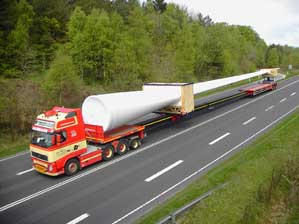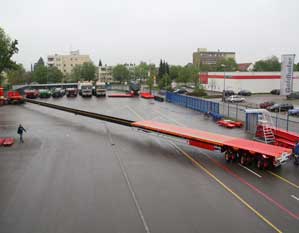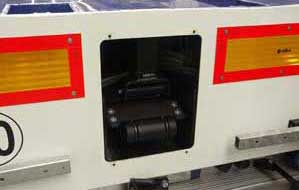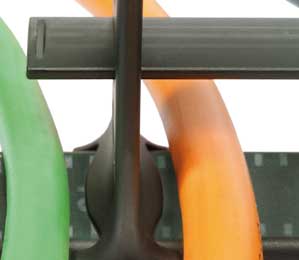Each millimeter counts
Energy supply systems for extendable heavy load transporterOperating conditions for energy supply systems cannot be more difficult: Extremely limited installation space, long travel and very high friction coefficients. Furthermore, the filling is extremely difficult. The holding times should also be agreeable with all that, or else high repair costs will accrue. Why the rugged Energy Chains® are technically and economically the first choice in the construction of an extendable heavy load transporter is shown in the following article.
"This vehicle has been specially designed for the transport of windmill wings," says Herbert Swoboda, chief designer of the semi-trailer of Goldhofer AG in Memmingen. "With the ability to extend the flatbed semitrailer three times to a total length of 62 m, it is possible to transport extremely long wings of windmills even in difficult terrain. " The vehicle was indeed designed for the safe transport of long windmill wings. Because of the enclosed cargo area, it can also be used as a universal vehicle with a payload of up to 38 tons. Energy supply systems are used in this customized vehicle to ensure the safe rolling of the electrical, brake and hydraulic cables in the inner tubes. It is the tested and proven "E4.1" series. One of their technical characteristics, the design principle of the so-called tongue and groove, provides a very high stability and structural safety. "That is all that matters to us," says chief designer Swoboda.

This telescoping three-axle semi-trailer truck of Goldhofer AG, Memmingen is extendable from 20 to 62 meters. In this picture it transports 55 m long rotor blades across Denmark.
"When extending the vehicle, the energy supply system is exposed to very strong push-pull forces, which they must simply endure in the long term. " The company Goldhofer with about 650 employees today has a history of more than 300 years. Started in 1705 as a forge, it has dedicated itself to intelligent solutions for the road, heavy goods and special transportation. The product range includes trailers, semitrailers, heavy goods transport systems and aircraft tugs. The specialist for heavy loads has already delivered more than 33,000 heavy-duty trucks and heavy load vehicles in over 70 countries worldwide.

Energy supply systems are used so that the electric, brake and hydraulic cables can roll safely in the inner tubes. The Energy Chains® are exposed to very strong push-pull forces especially when the vehicle is extended.
"We set global trends in the semitrailer sector," says Erich Traub of the marketing division of Goldhofer AG. "Our product range in this segment ranges from semitrailer through low-bed trailer up to combinable semitrailer trucks that can be driven over from the front. " At this year's 'bauma' in Munich, the company introduced, for example, a new flatbed semitrailer with pendulum axles. "For the first time it has succeeded in developing a transport vehicle with a maximum length of more than 62 meters," says chief executive Bernhard Katzenschwanz. The pendulum axles with an axle compensation of +/-300 mm give the vehicle an excellent maneuverability and can compensate for unevenness in both the stroke and in the lateral leveling. Moreover, it can be joined together under load to negotiate narrow passages or bends. This is enabled by the great resilience of the inner tube. "A first vehicle is already at work for a Danish heavy transport specialist; the construction of two more is planned," says Katzenschwanz.
In the development of the triple-telescopic platform, the extremely rugged energy supply systems were the first choice.
The technical requirements are extremely high. Above all, in the present application there is a safe rolling of the heavy supply cables in the telescope. The telescope system consists of four rectangular tubes. The energy supply lines run in minimum space in the innermost tube. Only a width of 340 mm and a height of 577 mm are available as installation space. Every millimeter counts here.
Second, the travel is very large. The loading length of the heavy transporter is 20,000 mm, which can extend three times – by 13,950 mm first time, 14,050 mm second time – to a total of 62,050 mm. "This length cannot be implemented with a single Energy Chain®," explains Herbert Swoboda. "Therefore, two Energy Chains® run side by side with different travel lengths. “
The longer energy supply line is responsible for the first two strokes, thus two expansion lengths. The shorter energy supply line takes over the last stroke, and also lies in a trough. The respective travel is 14,000 mm and 7,000 mm. The radius is the same in both cases, with 150 mm. The modification of the transporter's length is done using pneumatic locks with bolts. "The operation takes place invisibly in the tube and completely automatically," says Swoboda.

The two Energy Chains® lie side by side in the narrow black section. Only a width of 340 mm and a height of 577 mm are available as installation space.
"For this reason we need to rely on the functioning and stability of the Energy Chain® under all circumstances. " A further complication is that other forces may act on the energy supply system. "A tube can, for example, buckle while pulling put, so that the chain has to withstand jerky movements in the short term. " In addition the high temperature fluctuations in the tube - from -25°C to + 50°C depending on the season - also play a role.

Due to the cable-friendly plastic crossbars, the service life of the cables is increased by factor 4.
Normally in energy supply lines, the upper run runs on the lower run. It is reversed in this application. The top connection point is the fixed end and therefore rigid. The bottom connection point is the moving end and therefore pivots. When the telescope is joined together, the energy supply system has to negotiate a height difference quickly and safely. For this reason, moving the pivoting mounting bracket downward gives constructive advantages. The telescope thereby moves under the Energy Chain®. There is indeed, in this case, a small ramp, so that this process takes place as gently as possible, but still has to negotiate a projecting edge. There are also the coefficients of friction acting on the Energy Chains®. The tubes are made of untreated steel, and the surface is rough. Dust settles on it. When extending, enormous push-pull forces occur especially on the first two meters and particularly at the fixed end, which are absorbed by the tongue and groove of the "E4.1" chain.
Conclusion: The filling and the long travel in a confined space make high demands on the Energy Chains®, which are completely covered with cables. The meticulous designing during the run-up was worth it. The first trip of the flatbed semitrailer concluded without any problems. A Danish heavy transport specialist now transported 55 m long rotor blades from the factory to the port, from where the blades were shipped. Bends and roundabouts were no major challenges for the vehicle. "In my view, there is no economic and/or technical alternative to the energy supply system in this vehicle," summarizes Chief Designer Herbert Swoboda. "Our space availability is more than limited. For us, every single millimeter counts. Nonetheless the holding times should be right, as failure leads to very expensive repairs. And it has to be avoided in any case. “
More than 100,000 products available! Delivery and consultation Mon-Fri from 7am-8pm and Sat from 8am-12pm!